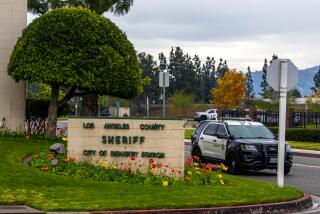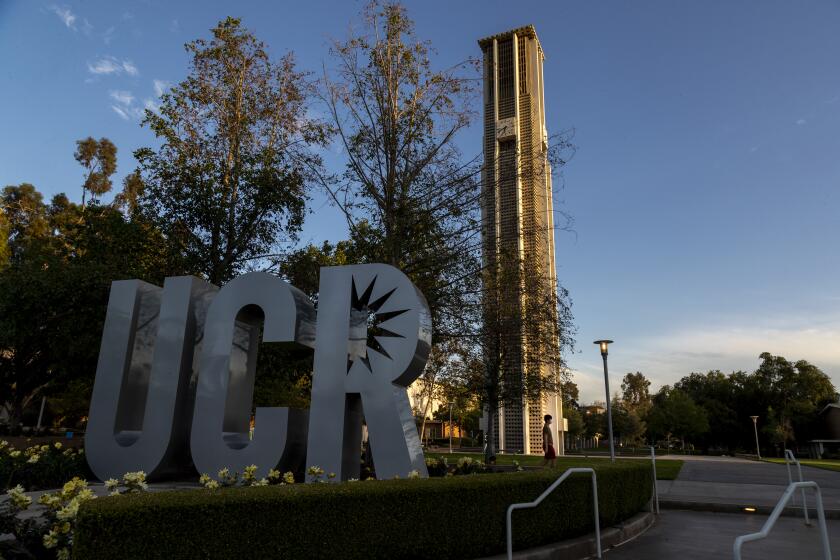Targets of Gang Injunctions Were Named by Officers in Police Probe : Rampart scandal: Seven alleged 18th Street members were arrested on the basis of sworn statements by LAPD members who were disciplined or are now under suspicion.
Nearly half of the 140 alleged members of the 18th Street gang named in sweeping court injunctions were accused, in part, on the basis of sworn statements from police officers caught up in the Los Angeles Police Department’s widening corruption investigation.
Moreover, seven of the 66 reputed gangsters named by officers who are now disciplined or under suspicion were arrested for violating the injunctions, which severely restrict gang members’ rights to congregate in public, a Times review of court records shows.
One gang member, who was sentenced to 250 days in jail, was arrested by since-fired LAPD Officer Rafael A. Perez, the admitted rogue cop providing information on corruption in order to obtain a more lenient sentence for theft of cocaine from the department’s evidence room.
The 20-year-old man was arrested in December 1997 for falsely identifying himself to Perez and violating the injunction, records show. The lawyer who represented the alleged 18th Street member could not be reached Wednesday for comment.
Overall, 20 arrests made in connection with the two injunctions are being investigated by prosecutors to see if they were proper.
The inquiry into the arrests is part of an increasingly complex probe hurriedly launched this week to gauge the damage done to the highly touted court orders used to crack down on the huge street gang rooted in the working-class neighborhoods west of downtown.
On Wednesday, a Superior Court judge temporarily halted all enforcement of a 1998 injunction in LAPD’s Rampart Division, where the corruption probe began.
The injunction, affecting neighborhoods around MacArthur Park, will go unenforced until at least early December.
Judge Fumiko H. Wasserman acted after Assistant City Atty. Marty Vranicar said prosecutors need that much time to conduct an exhaustive investigation of the evidence underpinning the injunction. On Tuesday, a different judge set aside a 1997 injunction affecting 18th Street members in the Pico-Union area.
The injunctions were granted after a series in The Times, which was based on reporting in the Rampart area and the far-flung neighborhoods where the notorious gang operates.
Prosecutors said they are still conducting their own review of the two injunctions.
But they insisted that the legal crackdowns could survive. Although at least a dozen officers are under scrutiny, it does not mean their sworn declarations are legally flawed, the prosecutors said. Many of the declarations were offered by officers who are not under suspicion, they noted.
Still, eight fired or suspended officers from the Rampart Division’s anti-gang squad, known as Community Resources Against Street Hoodlums (CRASH), which figures prominently in the corruption controversy, did submit sworn statements about individual gang members and their activities. In several instances, suspended or fired officers provided declarations for both injunctions, records show.
Former CRASH Officer Perez has said that he and a partner wrongly shot and framed a gang member. He also described a separate fatal shooting of an 18th Street member as “dirty.”
Different versions of both incidents were recounted in police declarations submitted under penalty of perjury to help win the injunctions.
In two other statements, a Rampart officer who was fired for allegedly beating an ex-gang member provided a lengthy overview of 18th Street activities. That officer, Brian Hewitt, provided evidence against 24 reputed gang members named in the injunctions. Hewitt’s attorney has said the allegations against his client are not well-founded.
Prosecutors face a daunting task in their injunction investigation. They must review dozens of sometimes lengthy sworn declarations provided by police officers.
Moreover, they must sift through voluminous details of the statements to eliminate any potentially tainted evidence. That could be a rapidly moving target because Police Chief Bernard C. Parks has warned that the corruption probe is just beginning and that he expects additional officers to be implicated.
Beyond that, prosecutors have to carefully examine all 20 arrests made under the injunctions for any legal problems.
Then, prosecutors must decide whether enough solid evidence remains to reinstate the injunctions.
“That’s a judgment call we’ll have to make after we get our arms around what these [officers] may be charged with,” Vranicar said.
Despite the considerable challenges, Vranicar vowed not to abandon the injunctions, a much-debated law enforcement tool pioneered by City Atty. James K. Hahn’s office.
“We made a commitment to this community,” Vranicar told reporters Wednesday outside the courtroom. “We’ll be back. I think this is just a temporary stay in the road.”
But the American Civil Liberties Union announced Wednesday that it is considering a full-scale legal challenge if prosecutors attempt to revive the injunctions.
“The ACLU is actively investigating the possibility of litigation,” said Elizabeth Schroeder, associate director of the group’s Southern California chapter.
Allegations that Rampart CRASH officers illegally shot and beat gang members and covered up a range of misconduct has completely undermined the injunctions’ legal footing, Schroeder said.
She added that the Rampart scandal is indicative of a larger problem within CRASH units citywide. She called for a probe of all 14 anti-gang injunctions approved in Los Angeles County in recent years.
“We need to come clean by doing a thorough citywide investigation,” Schroeder said.
*
Times staff writer Hudson Sangree contributed to this story.
More to Read
Start your day right
Sign up for Essential California for news, features and recommendations from the L.A. Times and beyond in your inbox six days a week.
You may occasionally receive promotional content from the Los Angeles Times.





